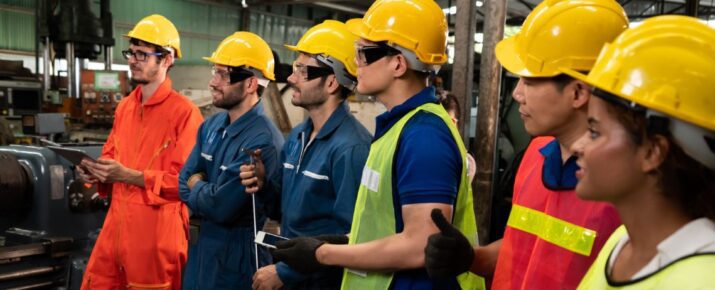How to Make the Most of Our New Way of Working
Ask The Experts | By | 23 Jun 2022 | 4 minute read

I was recently asked to take part in a webinar with Grow Remote to discuss Health and Safety matters whilst working remotely. We discussed my experience with remote working, as well as employers’ and employees’ legal requirements regarding health and safety.
A Look Into Remote Work
Working remotely wasn’t new to me when COVID and the request to ‘work from where you can’ kicked in. I managed the Quality, Health, Safety and Environment (QSHE) aspects for a freight forwarding company with 28 sites across UK and Ireland. For that position, I was unable to be at all the sites at once, and my team was small, so we worked remotely and visited sites regularly.
Remote work suits me. For one, I feel more productive control of my performance and output. It also fitted my work-life balance as a single mum.
During COVID and the introduction of technology, I was able to meet and see more people across the business from a global perspective. We worked together to manage the unprecedented situation we are all dealing with. Some team members preferred the regular interaction and ‘normal’ way of working, and there were some issues during the lockdown.
Benefits of Remote Work
We were all there, and we all have our own stories about the managed, or didn’t, during the pandemic. There are definite positives we can take away from how we worked during those two years.
For example, we learned to embrace technology like Zoom and Teams, which has improved collaboration and transparency within the business. Well-being topics were raised higher up the agenda in Health and Safety meetings, and managing the mental health of our colleagues has become a new skill for many managers I have spoken to. In fact, hybrid working is a new aspect that some people look for when applying for new positions. To support this shift, you can use eSIM as a digital nomad or remote worker to stay connected while on the go. With eSIM, remote workers can avoid roaming fees, easily switch between networks for stronger connections, and access seamless connectivity across regions, making it a valuable tool for a mobile lifestyle. Whether working from Europe, the APAC region, or Australia, eSIM keeps you connected even in more remote areas allowing for the flexibility to work from virtually anywhere. This flexibility is a game-changer for remote workers in digital nomad countries, making it easier to achieve a balance between work and travel, creating more enriching work experiences.
Challenges of Working Remotely
The way we work has changed and is still developing. Employers have a responsibility to ensure the safety of their employees wherever they are working, whether in in-house offices, remote offices, or virtual office space. Working remotely brings more challenges for employers due to hazards such as:
- Lone working
- Falling from the same height
- Electrical safety
- Workplace ergonomics
- Well-being
- Tripping over the cat
- Sitting on the sofa using a laptop
- Burning yourself on hot water from the kettle
- Poorly maintained electrical cables
- Feeling isolated from limited social interactions
Given this, how are employers expected to manage these risks?
Remote Work: Solutions for Success
Training and Awareness
Training and raising awareness is a good first port of call.
Training doesn’t have to be in the form of a formal lesson. For example, it could be a communication alert (Heads Up) reminding people to check the integrity of their electric cables. It could also come in the form of short incentivized sessions on their mobile device that encourages employees to consider their safety in the home (EdApp).
In my opinion, raising awareness of safety at home is an aspect that has been missing from the agenda of many businesses. For example, there are campaigns like the Royal Society for the Prevention of Accidents’(RoSPA) Safe@Work-Safe@Home initiative sponsored by Loreal.
Involving families and friends to consider health and safety outside of the workplace is a great way of increasing awareness and encouraging employees to take ownership of their own safety outside of the workplace. It also helps to remember that there is a fine line between being patronising and raising awareness. At the end of the day, everyone is responsible for safety inside and outside the workplace.
Risk Assessments
Carrying out risk assessments is the foundation of good safety practices and a legal requirement. Employers have the responsibility of identifying and managing risk in the workplace. However, if the workplace is someone’s home, this can be a challenge.
Display screen assessments can be completed remotely if designed well. Within the SafetyCulture public template library in SafetyCulture (formerly iAuditor), there are a few examples of well-designed templates that can be used to provide training and instruction and carry out an assessment.
During the pandemic, I used this process to review nearly 700 workstations without violating anyone’s home. If their score was below 80 percent, we called the individual on Teams and used our cameras for a one-to-one discussion. This process allowed us to support and advise them to ensure their workstation and work situation was adequate. And if it wasn’t, we’d discuss options and controls with their manager.
Reporting System
Having conversations with people is a great way to develop an open and honest culture which is important with hybrid and remote working.
The employer must provide a channel where employees can report any issues they are having. The culture within the business should be developed so that employees feel comfortable doing so. Moreover, it should be easy and quick to report.
The appropriate people must be notified of the reported issue so that it can be acted upon (Issues). After all, there is nothing worse than reporting an issue or a good idea with no response or acknowledgement.
If employees see actions from their reports, they are more likely to report again, which will continually improve the culture within your business.
Data-Driven Insights
The data generated by all of this reporting and communication can be overwhelming. It’s also vital because if you don’t measure, you can’t control it.
It’s useful to have a dashboard that shows you what trends are occurring in real-time. Doing so ensures compliance with processes and a transparent overview for management. The SafetyCulture platform has an analytical tool within the main dashboard or the capability of using API integrations by exporting data into a current company system.
Using technology to engage with a hybrid/remote workforce is fundamental. Not only does it streamline everyday work, but it also improves engagement, communication, and a continual improvement of a safety culture.
Final Thoughts
Finally, and on a side note, a question I am asked the most is, “Are we [the business] liable for an accident in the employee’s home if they work remotely?”
I’m not a solicitor, but I feel that this article by the IOSH Magazine covers it well. As a business, you’re on the best path to keeping your employees safe when working remotely at home as long as you have:
- identified and managed the risks;
- provided employees with adequate work equipment with suitable instruction, supervision, and training; and
- delivered a reporting process with a communication route for employees.
Important Notice
The information contained in this article is general in nature and you should consider whether the information is appropriate to your specific needs. Legal and other matters referred to in this article are based on our interpretation of laws existing at the time and should not be relied on in place of professional advice. We are not responsible for the content of any site owned by a third party that may be linked to this article. SafetyCulture disclaims all liability (except for any liability which by law cannot be excluded) for any error, inaccuracy, or omission from the information contained in this article, any site linked to this article, and any loss or damage suffered by any person directly or indirectly through relying on this information.





